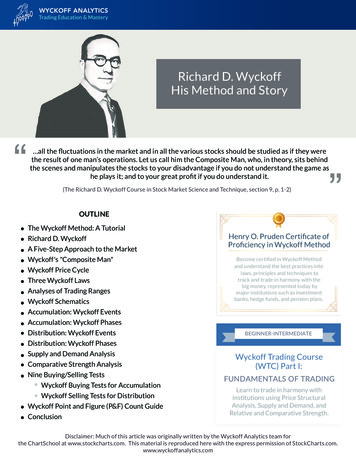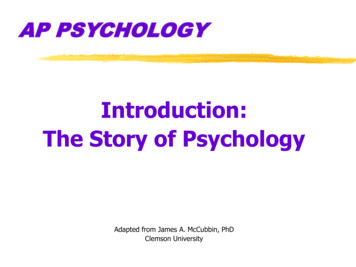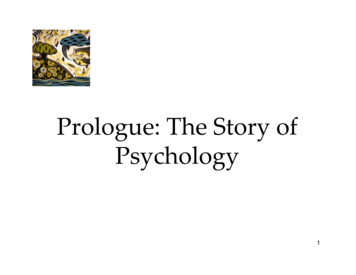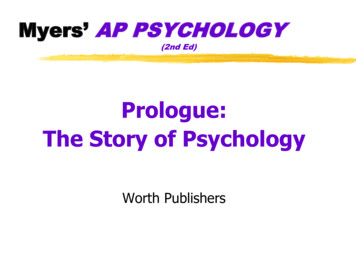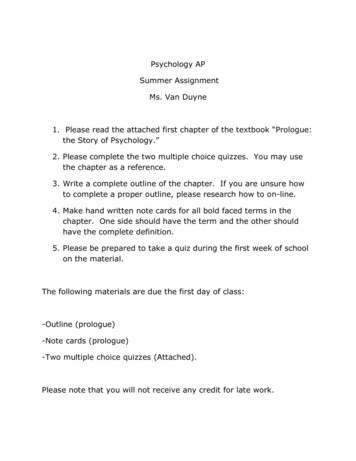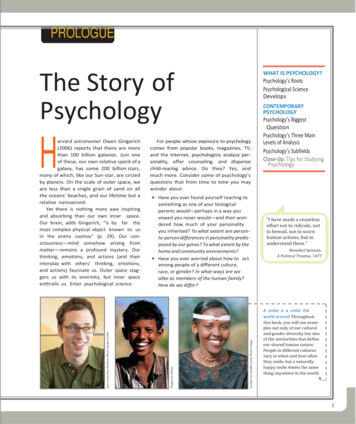
Transcription
PROLOGUEWHAT IS PSYCHOLOGY?The Story ofPsychologyHarvard astronomer Owen Gingerich(2006) reports that there are morethan 100 billion galaxies. Just oneof these, our own relative speck of agalaxy, has some 200 billion stars,many of which, like our Sun-star, are circledby planets. On the scale of outer space, weare less than a single grain of sand on allthe oceans’ beaches, and our lifetime but arelative nanosecond.Yet there is nothing more awe inspiringand absorbing than our own inner space.Our brain, adds Gingerich, “is by far themost complex physical object known to usin the entire cosmos” (p. 29). Our consciousness—mind somehow arising frommatter—remains a profound mystery. Ourthinking, emotions, and actions (and theirinterplay with others’ thinking, emotions,and actions) fascinate us. Outer space staggers us with its enormity, but inner spaceenthralls us. Enter psychological science.Psychology’s RootsPsychological ScienceDevelopsCONTEMPORARYPSYCHOLOGYFor people whose exposure to psychologycomes from popular books, magazines, TV,and the Internet, psychologists analyze personality, offer counseling, and dispensechild-rearing advice. Do they? Yes, andmuch more. Consider some of psychology’squestions that from time to time you maywonder about: Have you ever found yourself reacting tosomething as one of your biologicalparents would—perhaps in a way youvowed you never would—and then wondered how much of your personalityyou inherited? To what extent are personto-person differences in personality predisposed by our genes? To what extent by thehome and community environments?Have you ever worried about how to actamong people of a different culture,race, or gender? In what ways are wealike as members of the human family?How do we differ?Psychology’s BiggestQuestionPsychology’s Three MainLevels of AnalysisPsychology’s SubfieldsClose-Up: Tips for StudyingPsychology“I have made a ceaselesseffort not to ridicule, notto bewail, not to scornhuman actions, but tounderstand them.”Benedict Spinoza,A Political Treatise, 1677Ariadne Van Zandb/Lonely Planet ImagesMegapress/AlamyJohn Lund/Sam Diephuis/Blend Images/CorbisA smile is a smile theworld around Throughoutthis book, you will see examples not only of our culturaland gender diversity but alsoof the similarities that defineour shared human nature.People in different culturesvary in when and how oftenthey smile, but a naturallyhappy smile means the samething anywhere in the world. 1
2PROL OGUE::T H E S T OR Y OF P S Y C H O L O G Y Have you ever awakened from a nightmare and, with a wave of relief, wonderedwhy you had such a crazy dream? How often, and why, do we dream?Have you ever played peekaboo with a 6-month-old and wondered why the babyfinds the game so delightful? The infant reacts as though, when youmomentarily move behind a door, you actually disappear—only to reappear laterout of thin air. What do babies actually perceive and think?Have you ever wondered what leads to school and work success? Are some peoplejust born smarter? Does sheer intelligence explain why some people get richer, thinkmore creatively, or relate more sensitively?Have you ever become depressed or anxious and wondered whether you’ll everfeel “normal”? What triggers our bad moods—and our good ones?Such questions provide grist for psychology’s mill, because psychology is a sciencethat seeks to answer all sorts of questions about us all—how and why we think, feel,and act as we do.What Is Psychology?Psychology’s RootsONCE UPON A TIME, ON A PLANET IN this neighborhood of the universe, therecame to be people. Soon thereafter, these creatures became intensely interested inthemselves and in one another: “Who are we? What produces our thoughts? Our feelings? Our actions? And how are we to understand and manage those around us?”Psychological Science Is Born 1: When and how did psychological science begin? Information sources are cited inTo be human is to be curious about ourselves and the world around us. Before 300 B.C.,the Greek naturalist and philosopher Aristotle theorized about learning and memory,motivation and emotion, perception and personality. Today we chuckle at some of hisguesses, like his suggestion that a meal makes us sleepy by causing gas and heat to collect around the source of our personality, the heart. But credit Aristotle with askingthe right questions.Philosophers’ thinking about thinking continued until the birth of psychology aswe know it, on a December day in 1879, in a small, third-floor room at Germany’sUniversity of Leipzig. There, two young men were helping an austere, middle-agedprofessor, Wilhelm Wundt, create an experimental apparatus. Their machine measured the time lag between people’s hearing a ball hit a platform and their pressing atelegraph key (Hunt, 1993). Curiously, people responded in about one-tenth of a second when asked to press the key as soon as the sound occurred—and in about twotenths of a second when asked to press the key as soon as they were consciously awareof perceiving the sound. (To be aware of one’s awareness takes a little longer.) Wundtwas seeking to measure “atoms of the mind”—the fastest and simplest mentalprocesses. Thus began what many consider psychology’s first experiment, launchingthe first psychological laboratory, staffed by Wundt and psychology’s first graduatestudents.Before long, this new science of psychology became organized into differentbranches, or schools of thought, each promoted by pioneering thinkers. These earlyschools included structuralism and functionalism, described here, and three schoolsTo assist your active learning, I willperiodically offer learning objectives.These will be framed as questionsthat you can answer as you read on. parentheses, with name and date.Every citation can be found in the endof-book References, with completedocumentation that follows AmericanPsychological Association style.
PROL OGUE::T H E S T OR Y OF P S Y C H O L O G Ydescribed in later chapters: Gestaltpsychology (Chapter 6), behaviorism(Chapter 7), and psychoanalysis(Chapter 13).Wilhelm Wundt Wundt (far left)established the first psychologylaboratory at the University ofLeipzig, Germany. Thinking About the Mind’s FunctionsUnlike those hoping to assemble the structure of mind from simple elements—whichwas rather like trying to understand a car by examining its disconnected parts—philosopher-psychologist William James thought it more fruitful to consider theevolved functions of our thoughts and feelings. Smelling is what the nose does; thinkingis what the brain does. But why do the nose and brain do these things? Under the influence of evolutionary theorist Charles Darwin, James assumed that thinking, likesmelling, developed because it was adaptive—it contributed to our ancestors’ survival.Consciousness serves a function. It enables us to consider our past, adjust to ourpresent circumstances, and plan our future. As a functionalist, James encouragedexplorations of down-to-earth emotions, memories, willpower, habits, and momentto-moment streams of consciousness.Monika SuteskiThinking About the Mind’sStructure Throughout the text, importantconcepts are boldfaced. As you study,you can find these terms with theirdefinitions in a nearby margin and inthe Glossary at the end of the book. Edward Bradford TitchenerTitchener used introspection tosearch for the mind’s structuralelements. Monika SuteskiSoon after receiving his Ph.D. in1892, Wundt’s student Edward Bradford Titchener joined the CornellUniversity faculty and introducedstructuralism. As physicists andchemists discerned the structure ofmatter, so Titchener aimed to discover the structural elements ofmind. His method was to engage people in self-reflective introspection (looking inward), training them to report elements of their experience as they looked at a rose, listened to a metronome, smelleda scent, or tasted a substance. What were their immediate sensations, their images,their feelings? And how did these relate to one another? Titchener shared with theEnglish essayist C. S. Lewis the view that “there is one thing, and only one in thewhole universe which we know more about than we could learn from external observation.” That one thing, Lewissaid, is ourselves. “We have, so tospeak, inside information” (1960,pp. 18–19).Alas, introspection required smart,verbal people. It also proved somewhatunreliable, its results varying fromperson to person and experience toexperience. Moreover, we often justdon’t know why we feel what we feeland do what we do. Recent studies indicate that people’s recollections frequently err. So do their self-reportsabout what, for example, has causedthem to help or hurt another (Myers,2002). As introspection waned, so didstructuralism.3“You don’t know your own mind.”Jonathan Swift,Polite Conversation, 1738:: structuralism an early school of psychology that used introspection toexplore the structural elements of thehuman mind.:: functionalism a school of psychologythat focused on how our mental andbehavioral processes function—how theyenable us to adapt, survive, and flourish.
PROL OGUE::T H E S T OR Y OF P S Y C H O L O G YMonika Suteski4William James and Mary Whiton Calkins Monika SuteskiJames, legendary teacher-writer, mentoredCalkins, who became a pioneering memoryresearcher and the first woman to be president of the American PsychologicalAssociation.Margaret Floy Washburn The first womanto receive a psychology Ph.D., Washburn synthesized animal behavior research in TheAnimal Mind. James’ greatest legacy, however, came less from his laboratory thanfrom his Harvard teaching and his writing. When not plagued by ill healthand depression, James was an impish, outgoing, and joyous man, whoonce recalled that “the first lecture on psychology I ever heard was the firstI ever gave.” During one of his wise-cracking lectures, a student interrupted and asked him to get serious (Hunt, 1993). He was reportedly oneof the first American professors to solicit end-of-course student evaluations of his teaching. He loved his students, his family, and the world ofideas, but he tired of painstaking chores such as proofreading. “Send meno proofs!” he once told an editor. “I will return them unopened andnever speak to you again” (Hunt, 1993, p. 145).James displayed the same spunk in 1890, when—over the objections ofHarvard’s president—he admitted Mary Calkins into his graduate seminar(Scarborough & Furumoto, 1987). (In those years women lacked even theright to vote.) When Calkins joined, the other students (all men) droppedout. So James tutored her alone. Later, she finished all the requirementsfor a Harvard Ph.D., outscoring all the male students on the qualifyingexams. Alas, Harvard denied her the degree she had earned, offering her instead adegree from Radcliffe College, its undergraduate sister school for women. Calkinsresisted the unequal treatment and refused the degree. (More than a century later,psychologists and psychology students were lobbying Harvard to posthumouslyaward the Ph.D. she earned [Feminist Psychologist, 2002].) Calkins neverthelesswent on to become a distinguished memory researcher and the American Psychological Association’s (APA’s) first female president in 1905.When Harvard denied Calkins the claim to being psychology’s first female psychology Ph.D., that honor fell to Margaret Floy Washburn, wholater wrote an influential book, The Animal Mind, and became the secondfemale APA president in 1921. Although Washburn’s thesis was the firstforeign study Wundt published in his journal, her gender meant she wasbarred from joining the organization of experimental psychologistsfounded by Titchener, her own graduate adviser (Johnson, 1997). (What adifferent world from the recent past—1996 to 2009—when women claimedtwo-thirds or more of new psychology Ph.D.s and were 6 of the 13 electedpresidents of the science-oriented Association for Psychological Science. InCanada and Europe, too, most recent psychology doctorates have beenearned by women.)James’ influence reached even further through his dozens of wellreceived articles, which moved the publisher Henry Holt to offer a contractfor a textbook of the new science of psychology. James agreed and beganwork in 1878, with an apology for requesting two years to finish his writing. The text proved an unexpected chore and actually took him 12 years.(Why am I not surprised?) More than a century later, people still read theresulting Principles of Psychology and marvel at the brilliance and elegance withwhich James introduced psychology to the educated public.Psychological Science Develops2: How did psychology continue to develop from the 1920sthrough today?The young science of psychology developed from the more established fields of philosophy and biology. Wundt was both a philosopher and a physiologist. James was anAmerican philosopher. Ivan Pavlov, who pioneered the study of learning, was a Russ-
T H E S T OR Y OF P S Y C H O L O G Y5Sigmund Freud The controversialideas of this famed personality theorist and therapist have influencedhumanity’s self-understanding. Monika Suteskiian physiologist. Sigmund Freud, who developed an influential theory of personality, was an Austrian physician. JeanPiaget, the last century’s most influentialobserver of children, was a Swiss biologist. This list of pioneering psychologists—“Magellans of the mind,” asMorton Hunt (1993) has called them—illustrates psychology’s origins in manydisciplines and countries.The rest of the story of psychology—the subject of this book—develops atmany levels. With activities ranging fromthe study of nerve cell activity to thestudy of international conflicts, psychology is not easily defined.In psychology’s early days, Wundt and Titchener focused on inner sensations,images, and feelings. James, too, engaged in introspective examination of thestream of consciousness and of emotion.Freud emphasized the ways emotional responses to childhood experiences andour uncons
PROLOGUE The Story of Psychology WHAT IS PSYCHOLOGY? Psychology’s Roots Psychological Science Develops CONTEMPORARY PSYCHOLOGY Psychology’s iggest arvard astronomer Owen Gingerich (2006) reports that there are more than 100 billion galaxies. Just one of these, our own relative speck of a galaxy, has some 200 billion stars, many of which, like our Sun-star, are circled by planets.



